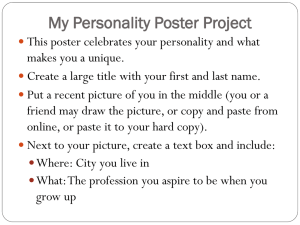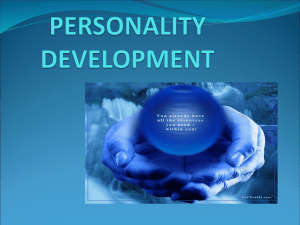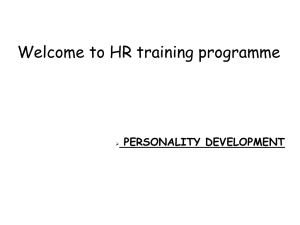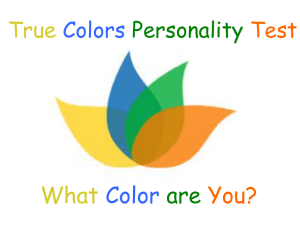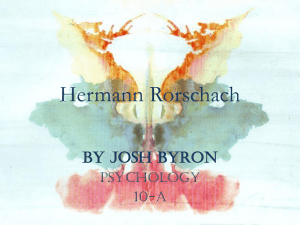- Idiotsguru
advertisement
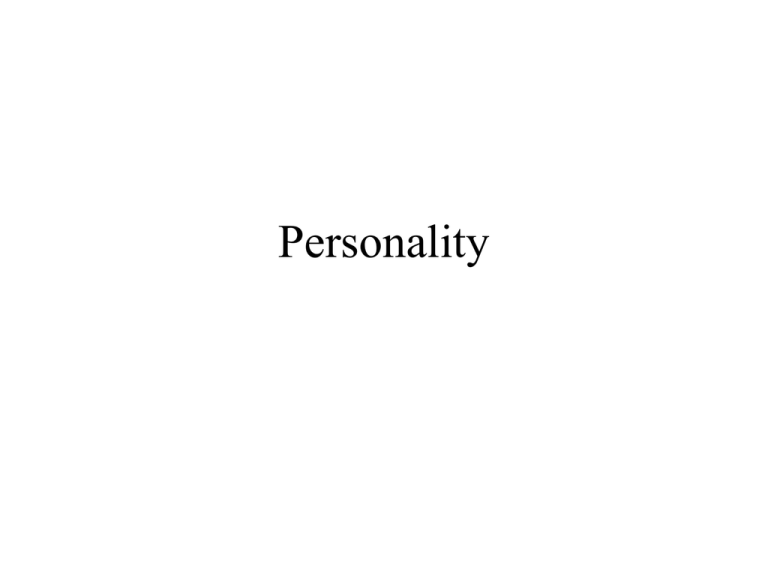
Personality What is Personality? People differ from each other in meaningful ways People seem to show some consistency in behavior Personality is defined as distinctive and relatively enduring ways of thinking, feeling, and acting Personality • Personality refers to a person’s unique and relatively stable pattern of thoughts, feelings, and actions • Personality is an interaction between biology and environment – Genetic studies suggest heritability of personality – Other studies suggest learned components of personality Four Theories of Personality 1. Trait 2. Psychoanalytic 3. Humanistic 4. Socio-Cognitive The First Trait Theory Moody Anxious Rigid Sober Pessimistic Reserved Unsociable Quiet UNSTABLE Touchy Restless Aggressive Excitable Changeable Impulsive Optimistic Active melancholic choleric INTROVERTED EXTRAVERTED phlegmatic sanguine Passive Sociable Careful Outgoing Thoughtful Talkative Peaceful Responsive Controlled Easygoing Reliable Lively Carefree Even-tempered Leadership Calm STABLE • Two Factor Trait Theory of Personality Personality Traits • Traits are relatively stable and consistent personal characteristics • Trait personality theories suggest that a person can be described on the basis of some number of personality traits – Allport identified some 4,500 traits – Cattel used factor analysis to identify 30-35 basic traits – Eysenck argued there are 3 distinct traits in personality • Extraversion/introversion • Neuroticism • Psychotocism Allport Overview of the Big “5” Assessing Traits: An Example • Minnesota Multiphasic Personality Inventory (MMPI) – the most widely researched and clinically used of all personality tests – developed to identify emotional disorders MMPI: examples • “Nothing in the newspaper interests me except the comics.” • “I get angry sometimes.” Evaluating Trait Theory • Trait theory, especially the Big 5 model, is able to describe personality – Cross-cultural human studies find good agreement for the Big 5 model in many cultures – Appear to be highly correlated not only in adulthood, but also in childhood and even late preschoolers – Three dimensions (extraversion, neuroticism and agreeableness) have cross-species generality • Problems with trait theory include: – Lack of explanation as to WHY traits develop – Issue of explaining transient versus long-lasting traits Psychoanalytic Theory • Psychoanalytic theory, as devised by Freud, attempts to explain personality on the basis of unconscious mental forces – Levels of consciousness: We are unaware of some aspects of our mental states – Freud argued that personality is made up of multiple structures, some of which are unconscious – Freud argued that as we have impulses that cause us anxiety; our personality develops defense mechanisms to protect against anxiety Freudian Theory Levels of consciousness Structures of Personality – Conscious • What we’re aware of – Preconscious – Id • Operates according to the “pleasure principle” • Memories etc. that can – Ego be recalled • Operates according to the “reality” principle – Unconscious – Superego • Wishes, feelings, impulses that lies • Contains values and beyond awareness ideals Freudian Theory Anxiety occurs when: – Impulses from the id threaten to get out of control – The ego perceives danger from the environment The ego deals with the problem through: – coping strategies – defense mechanisms Defense Mechanisms • Defense mechanisms refer to unconscious mental processes that protect the conscious person from developing anxiety – Sublimation: person channels energy from unacceptable impulses to create socially acceptable accomplishments – Denial: person refuses to recognize reality – Projection: person attributes their own unacceptable impulses to others – Repression: anxiety-evoking thoughts are pushed into the unconscious Defense Mechanisms • Rationalization: Substituting socially acceptable reasons • Intellectualization: Ignoring the emotional aspects of a painful experience by focusing on abstract thoughts, words, or ideas • Reaction formation: Refusing to acknowledge unacceptable urges, thoughts or feelings by exaggerating the opposite state • Regression: Responding to a threatening situation in a way appropriate to an earlier age or level of development • Displacement: Substituting a less threatening object for the original object of impulse Assessing the Unconscious • Projective Tests – used to assess personality (e.g., Rorschach or TAT tests) – How? provides ambiguous stimuli and subject projects his or her motives into the ambiguous stimuli Assessing the Unconscious -Rorschach • Rorschach Inkblot Test – the most widely used projective test – a set of 10 inkblots designed by Hermann Rorschach Rorschach Assessing the Unconscious-Rorschach used to identify people’s inner feelings by analyzing their interpretations of the blots Assessing the Unconscious--TAT Thematic Apperception Test (TAT) • people express their inner motives through the stories they make up about ambiguous scenes Psychoanalytic Neo-Freudian Alfred Adler – Humans are motivated by social interest – Takes social context into account – First Born • Privileged until Dethroned – Second Born • In shadow of 1st Born inferiority, restlessness – Youngest • Pampered, dependent – Only Child • Higher intellect, timid, passive, & withdrawn Psychoanalytic Neo-Freudian Carl Jung – A collective unconscious is represented by universal archetypes – Two forms of unconscious mind • Personal unconscious: unique for each person • Collective unconscious: consists of primitive images and ideas that are universal for humans Humanistic Theory • Humanistic personality theories reject psychoanalytic notions – Humanistic theories view each person as basically good and that people are striving for self-fulfillment – Humanistic theory argues that people carry a perception of themselves and of the world – The goal for a humanist is to develop/promote a positive self-concept Humanistic Perspectives Carl Rogers – We have needs for: • Self-consistency (absence of conflict between selfperceptions • Congruence (consistency between self-perceptions and experience) – Inconsistency evokes anxiety and threat – People with low self-esteem generally have poor congruence between their self-concepts and life experiences. Humanistic Perspectives ▲Abraham Maslow emphasized the basic goodness of human nature and a natural tendency toward self-actualization. Social/Cognitive Perspective • Proposed that each person has a unique personality because of our personal histories and interpretations shape our personalities ▲Albert Bandura’s social-cognitive approach focuses on self-efficacy and reciprocal determinism. ▲Julian Rotter’s locus of control theory emphasizes a person’s internal or external focus as a major determinant of personality. Locus of Control (Rotter) Internal locus of control – Life outcomes are under personal control – Positively correlated with self-esteem – Internals use more problem-focused coping External locus of control – Luck, chance, and powerful others control behavior





